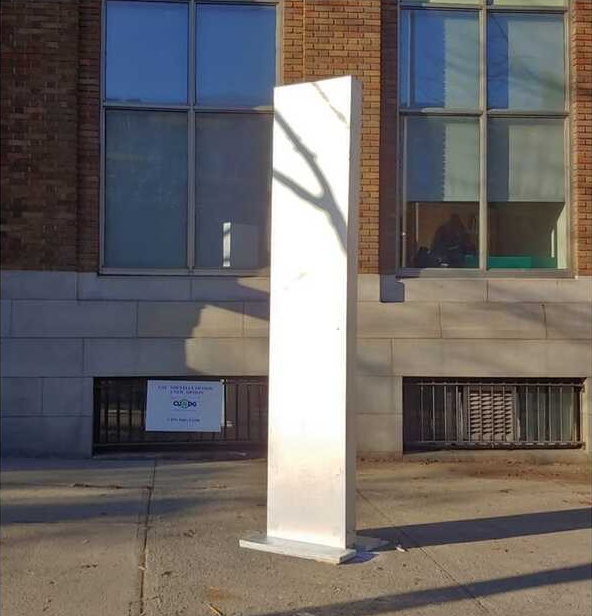Never again.

Never again.

Today, I had to widen a column in an Excel spreadsheet in which I record some numbers.

It is a spreadsheet that I use to keep track of confirmed COVID-19 cases.
The actual number of cases is likely much higher, since systematic testing is not available everywhere, and even where it is, people with milder symptoms or no symptoms at all may not get tested.
This number is also accompanied by the number of known COVID-19 fatalities: well over 2 million and counting, with the end nowhere in sight. COVID-19 may yet put the Spanish Flu to shame, despite a century of progress in medical science, despite the scientific miracle of rapidly developed, engineered I should say, mRNA vaccines.
Let me begin with a simple statement: I am not a parler.com fan.

But free speech is not about the freedom to publish things we all like. It is about the freedom to publish things we hate. Things that we find disgusting, revolting, reprehensible.
Of course, there has to be a line drawn somewhere. It is one thing to publish a racist rant about the inferiority of some human beings. It is another thing to call for genocide. Somewhere between these two is (or should be) a clear bright line: criminal “hate speech” is speech that calls for violence, speech that instructs readers to commit a crime.
Arguably, parler.com crossed this line multiple times when it failed to remove posts calling for violence against lawfully elected or appointed public officials, when it called for a violent uprising against the lawful government of the United States.
So what is my problem, then? Simple: I am alarmed by the idea that we are outsourcing the (legitimate, necessary) policing of the boundaries between free speech and criminal speech to corporations. Not just social media corporations like Facebook and Twitter, but also to corporations that provide fundamental Internet infrastructure, such as Amazon’s AWS.
As private corporations, these companies are of course well within their rights to deny their platforms to anyone, for whatever reason. But is this the world in which we wish to live? Where private corporations manage our fundamental communication infrastructure and decide who can or cannot communicate with the public?
This does not bode well for the future.
When the commercial Internet emerged, Internet Service Providers asked to be viewed by the law much like telephone companies: common carriers, that is, who are responsible for providing an infrastructure, but are not responsible for the content. (The telephone company does not become an accomplice by providing the service through which criminals arrange a crime.) But social media blurs this line, since these companies become the curators of user-supplied content, which they prioritize, filter, and use for advertising. And companies like AWS must be mindful of the content supplied through their infrastructure, since there are repercussions: letting an AWS VM spit out spam, for instance, can cause other service providers to block a range of AWS IP numbers affecting a large number of well-behaved AWS users.
But now, we have service providers that police political content. Even attaching labels like “the factual accuracy of this item is disputed” is questionable: Who disputes it? How can I trust the objectivity of the fact checkers who attach such labels? But things get much worse when Facebook or Twitter altogether ban someone like Trump from their respective platforms, or when AWS kicks out parler.com.
I am not questioning the judgment behind these individual cases. I am not questioning the necessity behind the decisions. Rather, I am questioning the haphazard, arbitrary, opaque process that lead to these actions. How can the same process that, say, led to Trump’s lifetime ban on Twitter still permit religious extremists, dictators and worse to spread hate or promote acts far more criminal than anything Trump has done?
There has to be a better way.
And I think there is a better way. Now is the time, I think, for this industry to create a nonprofit council that establishes and manages standards, adjusted if necessary to take into account applicable law in different jurisdictions. The institution should be arms-length, with secure funding, so that its decisions would not be swayed by undue influences or funding concerns. The process should be entirely transparent. And companies, especially social media and cloud computing infrastructure companies, should abide by the standards set by this council.
The alternative is just unacceptable. I don’t care how well-intentioned Facebook or Twitter or Amazon are, I do not wish our freedom of expression in our digital future to be opaquely managed by for-profit corporations.
I really don’t like power outages.
Today we had one.

Needless to say, Murphy’s law was also fully at work. I decided to shut everything down when it appeared that power was not going to come back soon (a fairly large area of Ottawa was affected), and of course, power came back two minutes later. But one of my UPSs didn’t come back online and needed a hard reset (unplug, remove the battery pack) while my desktop computer didn’t like it that suddenly a whole bunch of external hard drives, normally powered down, came to life as it was coming back from hibernation, and so it promptly crashed.
Oh, did I say that I don’t like power outages? I really don’t. Fortunately, as I recall, this was our first unscheduled power outage since the great Northeast blackout of 2003. So they do not happen often.
Still hate them, though.
I never thought I would feel this relieved listening to something so mundane: a perfectly normal, boring press conference from the White House, discussing policy details, executive actions, technicalities, in a professional and civil manner.

The adults are back in charge.

Coups d’état don’t succeed without support from the armed forces. That’s a historic given.
So when strangely clad “warriors” wearing fur hats and tattoos storm the Capitol Building in Washington DC, the sights are unsettling, people may die, but the stability of the United States government is not in any way in question.
But what happens when the troops who are supposed to prevent it from happening again themselves come under suspicion?

Just read the headline from the following Associated Press news release from minutes ago:
Just how the bleep do you vet over 20,000 troops hastily sent to Washington in less than 72 hours?
And what will that vetting do to their morale?
I am beginning to feel truly frightened.
I am reading an interdisciplinary paper, published in Frontiers in Conservation Science, about the likeliness of a much more ghastly future than usually predicted: A future characterized by deteriorating environmental conditions, mass extinctions, a collapsing ecosystem threatening human existence.
The concerns are real. The warnings should be heeded before it’s too late.
But… But, having read the article, I cannot escape the feeling that the authors themselves practice some of what they preach against.
They mention the “weaponization of ‘environmentalism’ as a political ideology”, rightfully expressing concern that as a result, environmental groups are often viewed as “terrorists” in many parts of the world. But then, later on, among the suggested remedies they list “the empowerment of women”.
Now I may be very fond of the idea of empowering women (I am) but I have to ask*: what does this have to do with climate and the ecosystem? Are women inherently better at being environmentally friendly? Do they have special abilities to understand climate science better than men? Or is it, heaven forbid, an actual example of someone, well-intentioned I am sure, sneaking in a desirable political goal by “weaponizing environmentalism” for ideological purposes?
*I could ask similar questions about “strict regulation of markets and property acquisition, reigning in corporate lobbying” (which appeared in the same sentence). While I may sympathize with reducing corporate influence by constraining campaign financing (I consider near unconstrained financing one of the core reasons behind the current democracy crisis in the United States), what on Earth does it have to do with climate or the ecosystem? I would also like to remind the authors that regimes that had strict regulations of markets and property acquisition, such as the socialist regime in which I grew up, have a terrible environmental track record: and yes, they tended to treat environmental groups as terrorists, insurrectionists or worse, precisely because such groups acted independently and refused to be controlled by those governments.
Tens of thousands of military personnel in Washington. Troops quartered in the Capitol building, reportedly for the first time since the US Civil War a century and a half ago. Establishment of a “Green Zone” like the one the US set up in Baghdad in 2003. An inauguration ceremony that is closed to the public, and not because of the raging pandemic. Threats of violence in every one of the 50 state capitals. News of rioters planning to assassinate public officials, including quite possibly the Vice President of the United States. News of lawmakers who feared that their lives might be threatened by… their fellow lawmakers, who are also conspiracy theory activists. News of other lawmakers who were afraid to vote to impeach the President because they felt that their lives were at risk if they did so. And law enforcement responding with not one but both hands tied behind their backs: not only are many of the insurrectionists themselves part of law enforcement, but they are cheered on by none other than the sitting President of the United States of America.

Can someone please tell me that this is just a bad dream, perhaps I got lost in one of Harry Turtledove’s alternate history novels, or perhaps a Netflix science-fiction series set in an alternate present, and that in reality, all is well?
Because if that’s not the case, I have to ask… Can someone please tell me what the bleep is happening?
In light of Trump’s Twitter suspension, my wife remarked: He deserved it.

He certainly did, but I am still of two minds about this one. More importantly, I am not at all certain that it is wise to call for criminal prosecution against him after he leaves office.
Not that he doesn’t deserve it. He deserves it a hundred times over.
But asking what he deserves is the wrong question.
Here is the right question: What will make the world, American democracy in particular, a better place years from now?
Vindictively dealing with politicians, no matter how badly they deserve it, is unlikely to accomplish that. In fact, it may create a precedent that will make it that much harder to remove future miscreants from office, that much more likely that they’ll cling to power, through unlawful means if necessary.
And make no mistake about it: the next wannabe despot will be a lot smarter, a lot more skillful than Trump.
And for all we know, the next wannabe despot will be driven by a bigger-than-life ideology, a messianic complex, a desire to change the world, as opposed to mere narcissistic, infantile egocentrism. And that person will be a lot more dangerous than Trump has ever been.
So this is what the US Capitol building looks like today:

Apparently, for some folks “democracy” is synonymous with “my way or the highway”, and they are willing to destroy democratic institutions to prevail. The pictures are beyond shocking. This is the kind of shit that we usually see coming from failed states in remote corners of the world, not the United States of America.
This is not the road to democracy. This is unadulterated fascism, and it’s not some exaggeration a’la Godwin’s law: This really is it.
I am thoroughly, thoroughly disgusted with Trumpists.
Tonight, this view of earthrise from the historical Christmas flight around the Moon by Apollo 8 seems and feels especially profound.

We are all in this together on our tiny blue marble. For now, hunkered down, but not beaten. As a result of 21st century science and an incredible push by researchers, we now have working vaccines that will soon be distributed to millions, starting with health care workers and the most vulnerable. Who could ask for a better Christmas present? And even amidst all this, we can still share a joke, as people from Romania to New Zealand, from Canada to Iran erect copycat versions of the famous Utah monolith.
[G]ood night, good luck, a Merry Christmas – and God bless all of you, all of you on the good Earth.
– Frank Borman, Apollo 8 mission commander
There is hope for us in 2021 on this good Earth.
I was recently interviewed by a Hungarian podcaster, mostly about my participation in the early days of game development in Hungary, but also about my more recent work, including my scientific contributions.
I just listened to the interview and thankfully, I didn’t say anything colossally stupid.
The year 2020 was certainly not… nice.
But there is a ray of hope. It arrived in the form of the mysterious metal monoliths that popped up all over the globe, most recently even here in our relative neighborhood, on Sherbrooke street in Montreal.

Similar monoliths appeared all over the planet, from British Columbia to Romania, from Iran to New Zealand.
And that makes me feel optimistic.
If, in a year like 2020, humanity can share a joke like this: people on all continents, from different cultures, can happily participate in a shared prank, a harmless diversion, making fun of it all… then, perhaps, there is hope for us yet.
In the last several days, until I asked Google not to show it anymore, this ad appeared on just about every other Web page that I visited:

As near as I can tell, it is inviting me to visit a clickbait site with some brainless list of “amazing inventions”. (Yes, I blurred out the address on purpose, because I have no desire to offer them free publicity.)
But what’s with this picture? It is… horrifying to be honest. If it is supposed to be an amazing invention, I wonder if it is an unusually gross sex toy or perhaps some quack medicine device.
Well, whatever it is… Google, please stop. This thing is… gross. (The machine-generated human face that seems to hit the bullseye in the middle of the uncanny valley doesn’t help either.)
A very nice article about our work on the Solar Gravitational Lens was published a few days ago on Universe Today, on account of our recent preprint, which shows quantitative results assessing the impact of image reconstruction on signal and noise.
Because the SGL is such an imperfect lens, the noise penalty is substantial. However, as it turns out, it is much reduced when the projected image area is large, such as when an exoplanet in a nearby star system is targeted.
While this is good news, the Sun’s gravitational field has other imperfections. We are currently working on modeling these and assessing their impact on noise. Next comes the problem of imaging a moving target: an exoplanet that spins, which is illuminated from varying directions, and which may have varying surface features (clouds, vegetation, etc.) Accounting for all these effects is essential if we wish to translate basic theory into sound scientific and engineering requirements.
So, the fun continues. For now, it was nice to see this piece in Universe Today.
I am watching an almost surreal (but beautiful) video.
In this video, ambassadors to the United States from Israel, Bahrain and the United Arab Emirates appear, exchanging warm greetings on account of the third night of Hanukkah.
The year 2020 is memorable mostly for all the wrong reasons, but if this remains one of the lasting legacies of 2020 and the Trump presidency, then perhaps it wasn’t a wasted year after all. After all, normalization of relations between Israel and Arab nations has been a decades long dream and until recently, very few people thought we’d live to see any meaningful results.
Yet here it is: the ambassador of a Gulf Arab state, lighting three candles on a menorah. What an astonishing sight.
According to the immortal Douglas Adams, God’s final message to His creation is simple: “We apologize for the inconvenience.”
But there’s also another final message of sorts, the answer to the Ultimate Question about Life, Universe, and Everything: 42.
Recently, a researcher by the name of Michael Hippke analyzed the seemingly random bits that are contained in minute fluctuations of the Cosmic Microwave Background (CMB) radiation. His conclusion: there is no discernible pattern, no appearance of constants of nature, no detectable statistical autocorrelation. The message is random.
I beg to respectfully disagree. In the 512-bit segment published by Hippke, the bit sequence 101010 appears no fewer than eight, er, nine times (one occurrence split between two lines).
Now if we only knew the question to which the answer is 42…
The giant Arecibo radio telescope is no more.

Damaged by a broken cable just a few weeks ago, the telescope completely collapsed today.
Incredibly sad news.
Completed in 1963, the telescope was 57 years old, just like me. I hope I will last a few more years, though.
It was less than three weeks ago that I blogged about a terrifying milestone: the number of new COVID-19 cases reached 100,000 a day in the great United States.
And now here we are today, with over 192,000 new cases registered in the past 24 hours.
Frankly, this is beyond terrifying, especially considering the horrific stories of many COVID-19 survivors about the debilitating consequences of this disease.